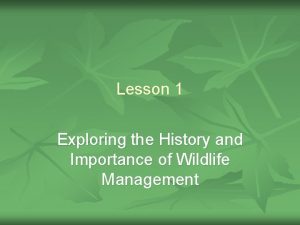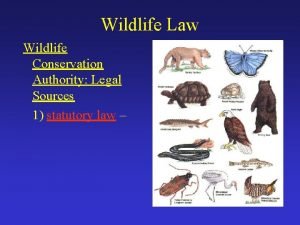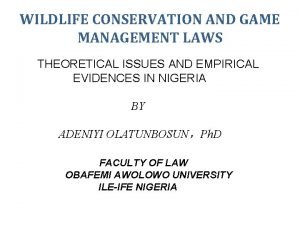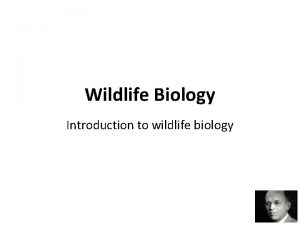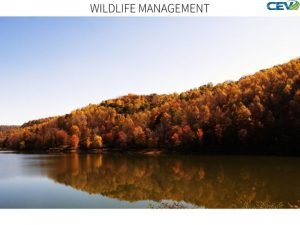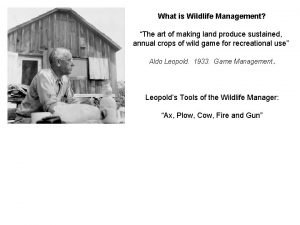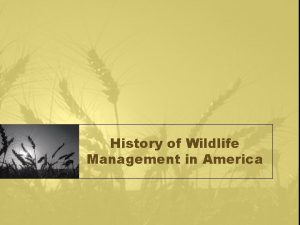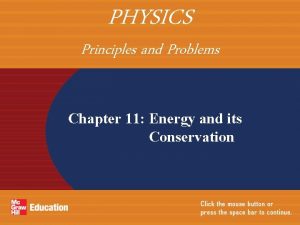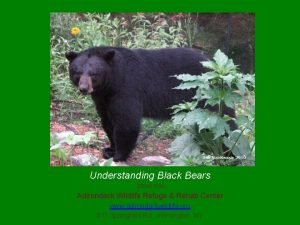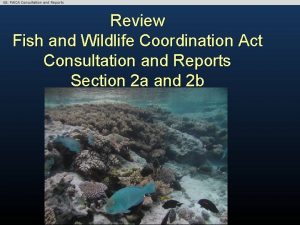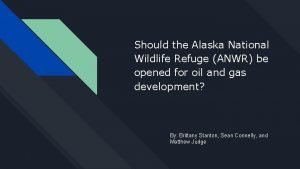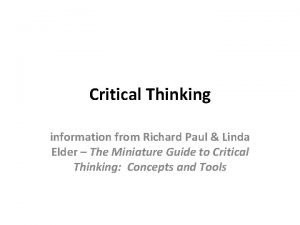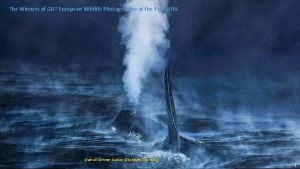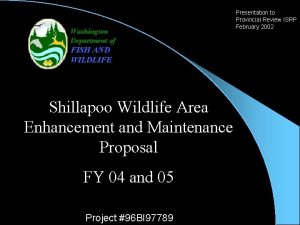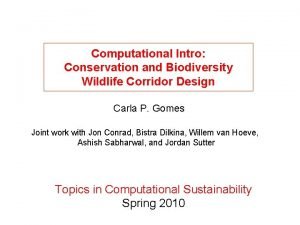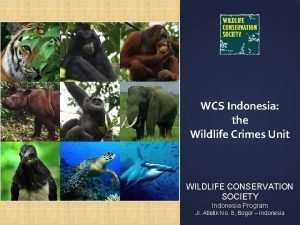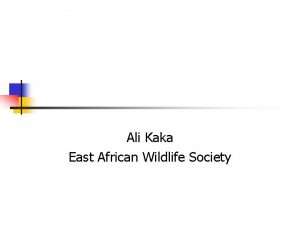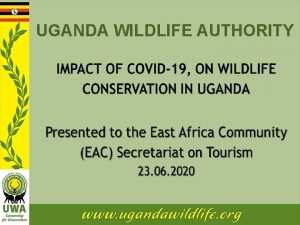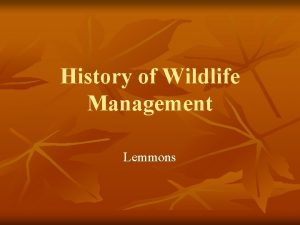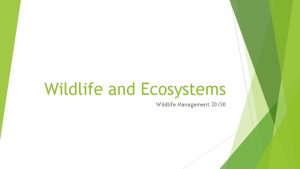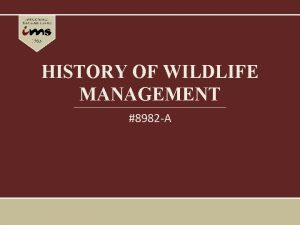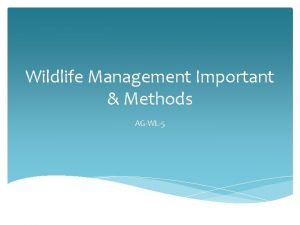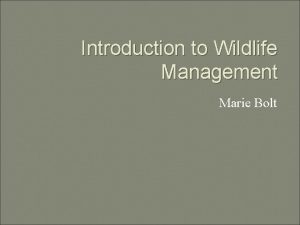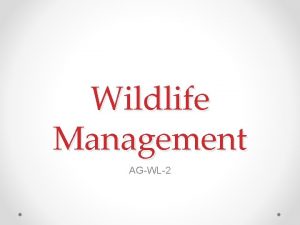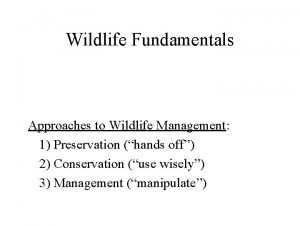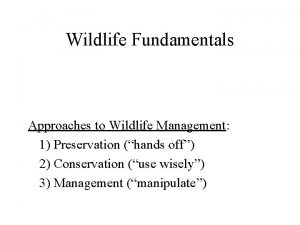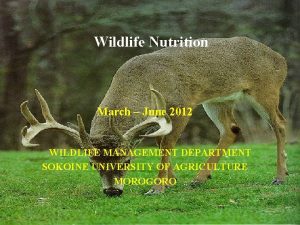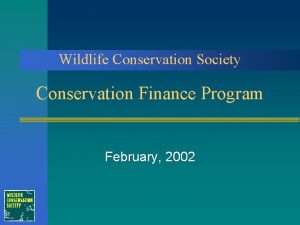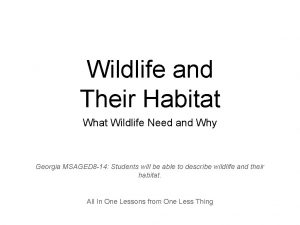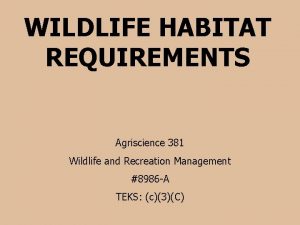Wildlife Conservation and Management Concepts that Guide Conservation






























- Slides: 30

Wildlife Conservation and Management

Concepts that Guide Conservation Biology • * a single large area of habitat is more effective at safeguarding species than several habitat fragments – can support larger populations – can support greater species richness • * it is better if areas of habitat for a given species are located close together rather than far apart – easier dispersal

Concepts that Guide Conservation Biology continued • * areas of habitat that lack roads or are inaccessible to humans are better than human-accessible areas • * it is more effective and economical to preserve intact ecosystems in which many species live than to work on preserving individual species one at a time

Techniques to “Save” Species • include: – protecting habitats – restoring damaged or destroyed habitats – zoos, aquaria, botanical gardens, and seed banks – forming conservation organizations

Protecting Habitats • currently, more than 3, 000 national parks, sanctuaries, refuges, forests, and protected areas throughout the world – some areas have multiple uses logging, grazing, mineral extraction, military exercises • can conflict with preserving species – not always effective not enough money or expertise to manage them – many areas are in biomes that have relatively few kinds of species (e. g. deserts)

Restoring Damaged or Destroyed Habitats • restoration ecology: the principles of ecology are used to help return a degraded environment to as close as possible to its former state – may cost a lot and take a long time, but can deter extinction

Zoos, Aquaria, Botanical Gardens, and Seed Banks • can save species on the brink of extinction e. g. collect eggs, captive breeding programs, etc. – techniques used include: • • artificial insemination embryo transfer reintroduction of endangered species to nature seed banks

Artificial Insemination • sperm collected from a suitable male of a rare species is used to artificially impregnate a female – e. g. black-footed ferret

Embryo Transfer • a female of a rare species is treated with fertility drugs so that she will produce multiple eggs – the eggs are collected, fertilized, and implanted in a related species • e. g. bongo calf and eland • e. g. Indian desert kitten and domestic cat

Reintroduction of Endangered Species to Nature • only 10% of reintroductions are successful • feasibility studies • social animals are released in small groups • can animals raised in captivity act as they do in the wild?

Seed Banks • advantages – can store a large amount of plant genetic material in a small space – seeds are safe from habitat destruction, climate warming, and neglect • disadvantages – some plants cannot be stored as seeds – seeds do not remain alive indefinitely – can be expensive – accidents (fires, power failures) can result in permanent loss – plants cannot evolve in response to environmental change

Ethics of “Saving” Species • we must prioritize what species “get saved” – it is too expensive to try to save all endangered species – how do we pick? ? ?

Conservation Organizations • groups help to educate policy makers and the public about the importance of biodiversity • can serve as catalysts for galvanizing public support for important biodiversity preservation efforts • provide financial support for conservation projects (research, land purchase, etc. )

Conservation Policies and Laws • U. S. policies and laws include: – the Endangered Species Act of 1973 (ESA) – the U. S. Biological Resources Discipline (BRD) • international policies and laws include: – the World Conservation Strategy – 1992 Earth Summit Treaty – the Convention on International Trade in Endangered Species of Wild Flora and Fauna (CITES)

The Endangered Species Act of 1973 • the ESA authorizes the FWS to protect endangered and threatened species in the United States AND abroad – conducts a detailed study of a species to determine if it should be listed – provides legal protection to listed species so that their danger of extinction is reduced – makes it illegal to sell or buy any product made from a listed species – requires the FWS to select critical habitats and design a detailed recovery plan for each species listed

Recovery Plans • include: – an estimate of the current population size – an analysis of what factors contributed to its endangerment – a list of activities that will be used to help the population recover • plans can include more than one species, or one species may have more than one plan

ESA Considerations • considered one of the strongest pieces of U. S. environmental legislation – why? – updates were made in ’ 82(*), ’ 85, and ’ 88 • one of the most controversial pieces of environmental legislation – property rights – financial costs of the law – impediment to economic progress?

*Habitat Conservation Plans (HCPs) • part of the 1982 update • provided a way to resolve conflicts between protection of endangered species and development interests on private property – allows a landowner to “take” a rare species if the “taking” does not threaten the survival or recovery of the listed species on that property – if a landowner sets aside land as habitat for the rare species, he/she then has the right to develop a different part of the property without threat of legal action by the FWS

ESA Compromises • more than 90% of endangered species live on at least some privately owned lands – give landowners incentives? • e. g. tax cuts for landowners who are good land stewards species would then be an ASSET, not a liability

Problems with the ESA • not many species have been delisted – BUT many species are stable or improving • the law is geared toward saving “sexy” organisms rather than the much larger number of less glamorous species that perform valuable ecosystem services • conservationists would like the ESA to manage whole ecosystems and maintain complete biodiversity rather than attempt to save endangered species as isolated entities – collective protection

CITES • the Convention on International Trade in Endangered Species of Wild Flora and Fauna (1975) – 160 countries participate – bans hunting, capturing, and selling of endangered or threatened species and regulates trade of organisms listed as potentially threatened – enforcement varies from country to country – who actually owns wildlife?

Wildlife Management • an applied field of conservation biology that focuses on the continued productivity of plants and animals – includes: • the regulation of hunting and fishing • the management of food, water, and habitat • often has different priorities than pure conservation biology – focuses on maintaining the population of a certain species (rather than on managing a community to ensure biodiversity in general)

Wildlife Management in Action • e. g. natural predators of many game animals have largely been eliminated in the U. S. (like wolves) – as a result, squirrels, ducks, and deer often exceed K – sport hunting can effectively control overpopulation of game animals • restrictions necessary

Methods of Wildlife Management • wildlife managers can affect a species by manipulating the plant cover, food, and water supplies of its habitat – control the stage of ecological succession – why? – use techniques such as planting certain types of vegetation, burning the undergrowth with controlled fires, and building artificial ponds

Management of Freshwater Organisms • e. g. trout, salmon • fishing laws • maintain natural habitats to maximize population size • restock ponds, lakes, and streams with young hatchlings

Management of Ocean Organisms • considered common property many marine species have been severely reduced in numbers by commercial fishing – commercial extinction: when so few of a species remain that it is unprofitable to hunt them • e. g. whale species (19 th and 20 th centuries)

Limits on Whaling • the 1946 International Whaling Commission set an annual limit for each whale species – BUT limits were set too high • moratorium on whaling in 1986 • 1994 establishment of the Southern Ocean Whale Sanctuary • Japan and Norway?

What Can WE Do About Declining Biodiversity? • we CAN reverse the trend toward extinction! – methods include: • increasing public awareness • supporting research in conservation biology • supporting the establishment of an international system of parks • controlling pollution • providing economic incentives to landowners and other local people

Providing Economic Incentives to Landowners and Locals • incentives encourage preservation, especially in developing nations that do not have much money to spend on conservation – allow them to charge fees for the use of genetic material? • bioprospecting agreements (e. g. the Suriname Biodiversity Prospecting Initiative) – promote ecotourism • conserves natural areas while improving the well-being of local people (e. g. Thailand’s coral reefs, tours of Costa Rica’s rainforests, Kenya’s safaris)

Economic Incentives continued • incentives continued: – debt-for-nature swaps: developed nations can forgive or reduce debts owed by developing nations in exchange for the agreement of the developing nation to protect biodiversity • e. g. the U. S. purchased $1 million of Madagascar’s national debt for their government’s support of local conservation efforts – reduce property taxes on privately owned land used as wildlife habitat
 Role of wildlife conservation
Role of wildlife conservation History of wildlife conservation
History of wildlife conservation Wildlife conservation law
Wildlife conservation law Introduction of wildlife conservation
Introduction of wildlife conservation A ___ resource cannot be remade once it is used.
A ___ resource cannot be remade once it is used. Phân độ lown ngoại tâm thu
Phân độ lown ngoại tâm thu Block nhĩ thất độ 3
Block nhĩ thất độ 3 Thơ thất ngôn tứ tuyệt đường luật
Thơ thất ngôn tứ tuyệt đường luật Thơ thất ngôn tứ tuyệt đường luật
Thơ thất ngôn tứ tuyệt đường luật Chiến lược kinh doanh quốc tế của walmart
Chiến lược kinh doanh quốc tế của walmart Tìm vết của mặt phẳng
Tìm vết của mặt phẳng Hãy nói thật ít để làm được nhiều
Hãy nói thật ít để làm được nhiều Tôn thất thuyết là ai
Tôn thất thuyết là ai Gây tê cơ vuông thắt lưng
Gây tê cơ vuông thắt lưng Sau thất bại ở hồ điển triệt
Sau thất bại ở hồ điển triệt Manipulative management wildlife
Manipulative management wildlife Objectives of wildlife management
Objectives of wildlife management Careers in wildlife management
Careers in wildlife management Wildlife management as an art
Wildlife management as an art History of wildlife management
History of wildlife management Physics chapter 11 study guide answers
Physics chapter 11 study guide answers Adirondack black bears
Adirondack black bears Site:slidetodoc.com
Site:slidetodoc.com Fish and wildlife coordination act
Fish and wildlife coordination act Arctic national wildlife refuge oil drilling pros and cons
Arctic national wildlife refuge oil drilling pros and cons Linda elder critical thinking
Linda elder critical thinking Mario cea sanchez
Mario cea sanchez Wildlife topics for presentation
Wildlife topics for presentation Explain wildlife
Explain wildlife Shillapoo wildlife area
Shillapoo wildlife area Wildlife corridor design
Wildlife corridor design

